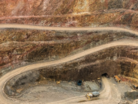Top 10 critical transition issues for mining

Mining companies, particularly the Top 40 referred to in PwC's latest report, must continue to develop strategies wherein trust is seen as a precious commodity. Only by developing and maintaining trust with a broad range of stakeholders will miners’ social licence to operate be assured, as the industry continues its critical transition from decarbonisation to sustainable operations. Here are 10 leading findings and issues extracted from the report.
10: More resources - but produced more sustainably
The shift to net zero will require more mining, not less. The rapid scaling of the lowemission energy systems of the future—solar and wind power, electric vehicles (EVs) and grid-scale batteries—will be highly material-intensive. The production of a solar farm requires three times more mineral resources than a similar-sized coal plant, and constructing a wind farm needs 13 times as much as a comparable gas-fired plant.
But providing resources for the energy transition is not simply a matter of mining more of the same materials in the same way. Instead, the world will need more critical minerals and raw materials to power the global economy of the future, and these resources will need to be mined sustainably.
09: Investing now ahead of economic resource scarcity
Economic resources are being depleted for many critical minerals, including copper, nickel and cobalt. The Top 40 will likely face more complex deposits and jurisdictions, and potentially higher costs in extracting the product and getting it to market. Improvements in technology for exploration and extraction will be essential in keeping pace with demand.
The Top 40 miners should have a sense of urgency to invest in the exploration, production, processing and refining of critical minerals now, not in a few years’ time, the report notes. The market is demanding it, and a new generation of miners is fast positioning itself to deliver the next generation of minerals.
08: Miners move down supply chains into value-added processes
Miners are evolving into producers of value-added chemicals. Kwinana, south of Perth, has emerged as one of the world’s leading critical minerals and shared infrastructure hubs. Other companies highlighted include Albemarle Corp (Kemerton lithium hydroxide processing plant), IGO Limited-Tianqi Lithium joint venture and Covalent Lithium joint venture.
07: OEMs and end users partner with mining operations
Many OEMs have progressively moved upstream in their supply chains to secure the supply of critical minerals, particularly the raw materials for lithium-ion batteries. OEMs are entering into joint ventures, partnerships and offtake agreements with miners and processors to secure supply.
If the direction of travel continues, expect to see OEMs become directly involved with critical minerals mining. Partnerships highlighted include BHP Nickel West-Tesla, Vale-Northvolt, Lake Resources-Ford and Indonesia Battery Corp-LG.
06: Adapting to more risk, scrutiny and volatility
The new generation of miners is highly aware of the industry’s rapidly changing operating environment. Governments, investors, customers, employees, suppliers and local communities are demanding that operators meet higher standards.
Governments in particular are taking on more activist roles to set higher ESG standards for operations, secure supply chains for critical minerals and manage increasing geopolitical risks.
05: The future of thermal coal
Increased demand for thermal coal in Asia, tight supplies of natural gas, and sanctions on Russian coal exports are continuing to increase thermal coal prices in 2022. As a result, coal is forecast to overtake copper as the leading revenue source of PwC's Top 40 report.
However given that many Top 40 miners have stated an intention to exit coal assets, it's unlikely coal’s revenue contribution will be sustained.
04: Spending wisely
Although investment in capital expenditures and exploration rose in 2021, it fell short of expectations, as supply chain bottlenecks and COVID-19 restrictions delayed key projects. Provided that projects can be delivered, we forecast a 14% increase in capital expenditures in 2022, on top of the 18% increase seen in 2021.
As the Top 40 ramp up spending, they’ll need to consider their investments carefully, in light of rising inflationary pressures and continued supply chain issues.
03: Revisit deal strategy
Think carefully about your M&A strategy in the context of the fundamental changes affecting mining, the market for mining products and your longterm strategic position.
Consider the impact of high volatility in the short to medium term, increased geopolitical risks and competition from new players.
Leverage rock-solid balance sheets, strong cash flow and a positive earnings outlook to reposition towards long-term growth while balancing shareholder distributions.
02: Take a position on critical minerals
Three key recommendations when it comes to critical minerals:
- Review your exposure to critical minerals and materials for the energy transition.
- Evaluate opportunities to own more of the supply chain or to partner directly with OEMs.
- Evaluate development models around shared infrastructure solutions, potentially expediting timelines and lowering upfront capital costs.
01: Double down on ESG
Every miner has a role to play in building trust in brand mining and establishing strong social licences and responsible M&A is crucial.
In 2021, S&P Global began publishing a ‘green aluminium’ pricing index, showing that customers are willing to pay an extra US$10–$15 per tonne for aluminium made sustainably. These kinds of green premiums will only continue to grow as consumers become more discerning about supply chains and provenance.
The OECD’s Pillar 2 (global minimum tax) is fast approaching, and miners should act quickly to prepare for its potential impact.
Green premiums and a reduced cost of capital are opportunities resulting from ESG that miners should explore further.



